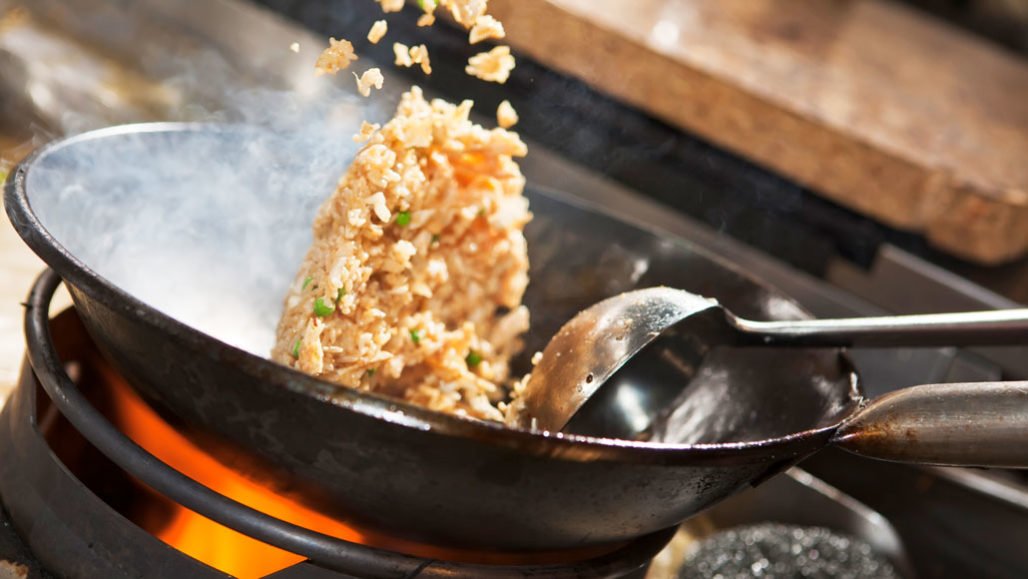Chef Kwok Keung Tung skillfully maneuvers the wok, effortlessly tossing its contents with one hand while expertly wielding a metal spatula with the other. Balancing both hands in this culinary dance, he deftly manipulates the gas stove’s lever with his knee, controlling the fire fan to intermittently engulf a third of the wok in flames. In a mere three minutes, a mound of white rice undergoes a magical transformation into a golden bowl of fried rice, exuding what is known as “wok hei” – the breath of the wok.
According to Danny Yip, co-founder of The Chairman, a renowned Hong Kong restaurant recently crowned the No.1 in Asia, the wok is the quintessence of Chinese cooking in South China. Cantonese chefs, in particular, are hailed as masters of fire and wok. For those immersed in Cantonese culture, phrases like “gau wok hei” (enough wok hei) or “ng gau wok hei” (not enough wok hei) are commonplace when evaluating the authenticity of a Chinese restaurant.
Wok hei, where “hei” signifies energy flow in Cantonese, was once an elusive and abstract concept primarily popular in South China. Grace Young, the legendary American Chinese food writer, brought it into the international spotlight by poetically terming it “the breath of a wok” in her 1990s book “The Wisdom of the Chinese Kitchen.”
Recent years have seen increased interest from both food writers and scientists in delving into the science behind Chinese cooking, including the phenomenon of wok hei. Hung-tang Ko, a doctoral student at the Georgia Institute of Technology, collaborated with scientist David Hu to publish a research paper titled “The physics of tossing fried rice.” Their investigation explored the physics behind the tossing of fried rice in a wok, emphasizing the importance of high heat in achieving both wok hei and the Maillard reaction.
The Maillard reaction, a chemical interplay between amino acids and reducing sugars under high heat, results in browning and the release of aromatic flavors. Ko explains that the intense heat from commercial Chinese stoves plays a pivotal role in unlocking the maximum wok hei in the shortest time, preventing the escape of aromas generated by the Maillard reaction.
Tossing a wok is a specialized skill that requires extensive practice. At The Chairman, young chefs spend over a year honing their wok-tossing abilities before stir-frying dishes for customers. The unique round-bottomed and highly conductive wok enhances the uniform distribution of heat, but the rapid tossing motion, averaging 2.7 times per second, often leads to muscle injuries for chefs.
Ko’s research aimed not only to understand wok tossing but also to explore the feasibility of creating a robot to assist chefs, alleviating physical strain. He envisions applying the wok tossing mechanics to other areas of life, such as a laundry drying machine.
Perfecting fried rice, a dish crucial for evaluating a restaurant’s wok hei, involves maintaining high heat and meticulous mixing. Avoiding watery content and employing leftover rice cooked the night before contribute to achieving the desired texture and flavor. The Chairman, however, takes a unique approach by using fresh rice and relying on the chef’s skill to quickly mix ingredients, ensuring each grain is perfectly coated and bursting with flavor.
In the world of fried rice, nuances matter, as highlighted by a viral YouTube video featuring “Uncle Roger” critiquing a BBC video on cooking egg fried rice. Hong Kong chefs, like those at The Chairman, emphasize that achieving the ideal texture – slightly toasted and evenly mixed without burning – is a challenging art.
Whether through scientific studies or culinary traditions, the pursuit of the elusive wok hei continues to captivate those seeking the perfect bowl of fried rice.
